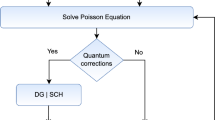Abstract.
We present a new parallel semiconductor device simulation using the dynamic load balancing approach. This semiconductor device simulation based on the adaptive finite volume method with a posteriori error estimation has been developed and successfully implemented on a 16-PC Linux cluster with a message passing interface library. A constructive monotone iterative technique is also applied for solution of the system of nonlinear algebraic equations. Two different parallel versions of the algorithm to perform a complete device simulation are proposed. The first is a dynamic parallel domain decomposition approach, and the second is a parallel current-voltage characteristic points simulation. This implementation shows that a well-designed load balancing simulation can significantly reduce the execution time up to an order of magnitude. Compared with the measured data, numerical results on various submicron VLSI devices are presented, to show the accuracy and efficiency of the method.
Similar content being viewed by others
Author information
Authors and Affiliations
Rights and permissions
About this article
Cite this article
Li, Y., Sze, S. & Chao, TS. A Practical Implementation of Parallel Dynamic Load Balancing for Adaptive Computing in VLSI Device Simulation. Eng Comput 18, 124–137 (2002). https://doi.org/10.1007/s003660200011
Issue Date:
DOI: https://doi.org/10.1007/s003660200011




